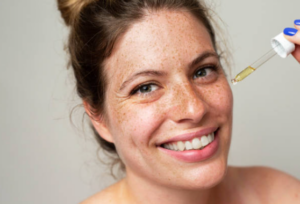Navigating the Skincare Maze

In the ever-evolving world of skincare, understanding the chemistry behind your products is key to unlocking their full potential. Retinol, a potent derivative of vitamin A, is celebrated for its transformative effects on the skin. However, its compatibility with other skincare ingredients can be a delicate dance. To achieve optimal results and maintain skin health, it’s crucial to know what to avoid mixing with retinol. This guide delves into Skincare Chemistry 101, outlining the do’s and don’ts of combining retinol with other products to ensure a harmonious and effective skincare routine.
The Power of Retinol: A Brief Overview
What is Retinol?
Retinol, a derivative of vitamin A, is a powerhouse ingredient renowned for its ability to promote cell turnover, boost collagen production, and address various skincare concerns. It’s a common ingredient in anti-aging formulations, tackling fine lines, wrinkles, and uneven skin tone.
How Retinol Works
Retinol works by speeding up the skin’s natural exfoliation process, shedding old skin cells to reveal fresh, new ones. This process not only improves texture but also stimulates collagen synthesis, resulting in firmer, more youthful-looking skin.
What Not to Mix with Retinol
Avoid Mixing Retinol with Vitamin C
While both retinol and vitamin C offer powerful antioxidant benefits, combining them can be counterproductive. The acidity of vitamin C can destabilize retinol, potentially reducing its efficacy. To benefit from both ingredients, use them at different times of the day or on alternate days.
Caution with Benzoyl Peroxide
Benzoyl peroxide is a potent acne-fighting ingredient, but when combined with retinol, it can lead to irritation and decrease the effectiveness of both ingredients. If you use both, consider using them at different times of the day or on alternating days to minimize potential interactions.
Retinol and Alpha Hydroxy Acids (AHAs)
AHAs, like glycolic and lactic acid, are exfoliants that enhance cell turnover. While both retinol and AHAs offer skin-renewing benefits, using them together may increase the risk of irritation. If you want to incorporate both, use them on alternate evenings or consult with a dermatologist for a personalized approach.
Niacinamide and Retinol
A Delicate Balance: Niacinamide, a form of vitamin B3, is known for its soothing and anti-inflammatory properties. Some studies suggest that combining niacinamide with retinol may reduce its efficacy. While research is ongoing, it’s advisable to use these ingredients at different times or on alternate days to avoid potential conflicts.
Retinol and Physical Exfoliants
Physical exfoliants, such as scrubs or brushes, can be abrasive to the skin, especially when used in conjunction with retinol. The increased sensitivity from retinol makes the skin more susceptible to irritation and microtears. Consider skipping physical exfoliation on the days you use retinol to prevent over-exfoliation.
Building a Retinol-Compatible Skincare Routine
Layering Retinol with Hyaluronic Acid
Hyaluronic acid is a hydrating powerhouse that complements retinol well. While retinol may temporarily reduce the skin’s moisture levels, hyaluronic acid helps replenish hydration. Apply hyaluronic acid serum before retinol to boost moisture and minimize potential dryness.
Retinol and a Good Moisturizer
To counteract any dryness or irritation that may occur with retinol use, incorporate a rich and nourishing moisturizer into your routine. Applying moisturizer after retinol helps lock in hydration and soothe the skin.
Sunscreen: A Non-Negotiable Step
Retinol can increase the skin’s sensitivity to UV radiation, making sunscreen a crucial step in your routine. Use a broad-spectrum sunscreen with at least SPF 30 every morning, even on cloudy days, to protect your skin from potential sun damage.
Retinol in the Evening, Hydrating Ingredients in the Morning
Consider using retinol in the evening as part of your nighttime routine. In the morning, focus on hydrating and protective ingredients, such as antioxidants and peptides, to support your skin throughout the day.

Common Concerns and Troubleshooting
Managing Irritation
If you experience irritation from retinol, consider reducing the frequency of use or opting for a lower concentration. Additionally, apply retinol to dry skin after cleansing to minimize potential sensitivity.
Combining Retinol with Prescription Medications
If you’re using prescription-strength retinoids, it’s crucial to follow your dermatologist’s recommendations. Combining them with other active ingredients may require a customized approach based on your specific skincare needs.
Consulting with a Dermatologist
If you’re unsure about how to incorporate retinol into your routine or have concerns about potential interactions, consulting with a dermatologist is advisable. They can provide personalized guidance based on your skin type, concerns, and the products you’re using.
In the realm of skincare chemistry, understanding what not to mix with retinol is as important as knowing its benefits. By navigating the do’s and don’ts of combining retinol with other ingredients, you can harness its transformative power without compromising your skin’s health. Remember, skincare is a personalized journey, and finding the right balance requires patience, consistency, and a commitment to understanding your skin’s unique needs. With the right knowledge, you can master the art of retinol harmony and embark on a journey towards healthy, radiant skin.

